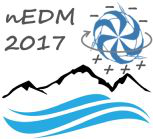Speaker
Prof.
Tim Chupp
Description
EDM measurements in a number of systems are needed to sort out the theoretical meaning of the current experimental landscape (represented by a set of upper limits) and to interpret a potential future discovery. A global analysis of EDM results in the context of a restricted set of low-energy parameters that follow from an effective-field theory approach shows that there is currently no model-independent constraint on the EDM of any experimentally accessible system. Thus even though 199Hg is intrinsically more sensitive to most sources of CP violation and the experiment is more sensitive to the atomic EDM than 129Xe, the discovery potential in 129Xe is just beyond the current limit. Moreover the constraining the hadronic parameters including CP-violating pion-nucleon couplings, a short-range contribution to the neutron EDM and a CP-violating atomic electron-nucleus coupling is most limited by the current experimental sensitivity for129Xe. Improving the 129Xe EDM sensitivity is thus strongly motivated. An approach that could in principle provide one or more orders of magnitude sensitivity is the measurement of free precession using SQUID magnetometers in an exquisitely controlled magnetic environment with 3He comagnetometry - the HeXe experiment. Developments of SQUID magnetometery and magnetically-shielded rooms at TUM-Garching, PTB in Berlin, EDM cells with collaboration from Juelich Neutron Scattering Center, and noble gas polarization also at Michigan, have culminated in a recent EDM measurement that is being evaluated. The global analysis of EDM results related to our motivation and progress towards a measurement that realizes the potential of these techniques will be described.
| chupp@umich.edu |

